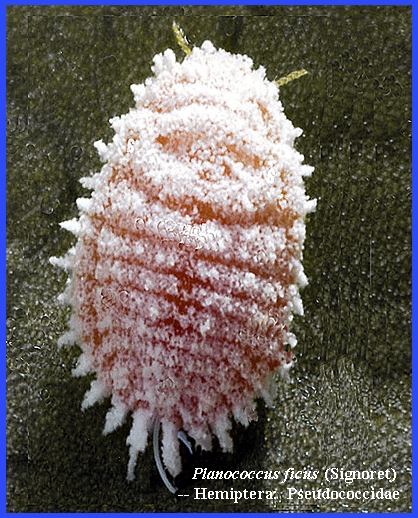File: <vinemealybug > Pooled References GENERAL
INDEX [Navigate to MAIN MENU ]
|
Vine Mealybug Planococcus ficus (Signoret) -- Hemiptera: Pseudococcidae |
------ CLICK on photo to enlarge. To search
for Subject Matter, Depress Ctrl/F
----------------------------------------------------------------------------------------------------------------------------------
|
Vine
mealybug is now found throughout the Mediterranean region, South Africa,
parts of Asia, and Mexico. After its
arrival in the Coachella Valley (Riverside County) the vine mealybug has
spread to the San Joaquin Valley, foothills of the Sierra Nevada, Central
Coast, and eventually North Coast vineyards.
The long range and rapid spread of the insect throughout the state is
likely the result of transportation of contaminated nursery plant material
and field equipment. As of 2007 vine
mealybug is known to be established in 17 California counties, which include
most of the major wine, raisin and table grape producers. With the exception of a putative
eradication in El Dorado County, populations of vine mealybug persist in
these regions and are likely to have a worldwide distribution. Originally believed to be spread only by
infected propagation material, the mealybug was considered a minor problem or
even a boon for wine quality. Recent
outbreaks in the Western United States associated with new infestations of
vine mealybug and other mealybug vectors have changed this perception. Vine mealybug is now prevalent throughout
California vineyards and is considered a significant economic threat. The
vine mealybug produces abundant honeydew that causes sooty mold damage. High densities of the insect lead to
decreased plant vigor, defoliation, and the insects themselves may be
entrapped in grape clusters. However,
because vine mealybug is an efficient vector of grapevine leafroll associated
viruses it can cause damage even at relatively low densities. Effects of the virus infection differ
among grape varieties. Among the most
susceptible grapes, infection causes reddening of leaves, curling of their
margins, decreased plant vigor, and leaf drop. Finally this delays ripening of fruit and reduces quality and
yield. REFERENCES:
FURTHER RELATED REFERENCES Allsopp,
E. 2016. Transmission of
Grapevine Leafroll-associated Virus 3 by Vine Mealybug, Planococcus ficus (Signoret), to
Grapevines Treated with Imidacloprid.
South African Journal of Enology & Viticulture. 36 (2). Bugg,
Robert L. & Carol Waddington.
1994. Using cover crops to manage arthropod pests of orchards: A review. Agriculture, Ecosystems
& Environment. 50 (1): 11–28. Cocco,
Arturo; Enrico Muscas, Alessandra Mura, Andrea Iodice, Francesco Savino &
Andrea Lentini. 2018. Influence
of mating disruption on the reproductive biology of the vine mealybug, Planococcus ficus (Hemiptera:
Pseudococcidae), under field conditions. Pest Management Science. 74 (12): 2806–2816. Daane,
Kent M.; Monica L. Cooper, Sergei V. Triapitsyn, Vaughn M. Walton, Glenn Y.
Yokota, David R. Haviland, J.
Bentley, Kris E. Godfrey & Lynn R. Wunderlich. 2008.
Vineyard managers and
researchers seek sustainable solutions for mealybugs, a changing pest complex. California
Agriculture. UC Agriculture
and Natural Resources 62 (4):
167–176. Daane,
Kent M.; Charles Vincent, Rufus Isaacs & Claudio Ioriatti. 2018.
Entomological Opportunities
and Challenges for Sustainable Viticulture in a Global Market. Annual Review of Entomology. 63 (1): 193–214 Flaherty,
D. 1982. Major insect and mite pests;
In: Grape Pest
Management, Agricultural Sciences Publications. 4105: 412 Hollingsworth,
Robert G. 2005. Limonene,
a Citrus Extract, for Control of Mealybugs and Scale Insects. Journal of Economic Entomology. 98
(3): 772–779 Tanne,
Edna; Y. Ben-Dov & H. Raccah.
1989). Transmission of the corky-bark disease by the mealybug Planococcus ficus. Phytoparasitica. 17 (1): 55–55. Walton,
V. M. & K. L. Pringle. 2017a.
Effects of Pesticides and
Fungicides Used on Grapevines on the Mealybug Predatory Beetle Nephus
boschianus (Coccinellidae, Scymnini). South African Journal of Enology &
Viticulture. 22 (2). Walton,
V. M. & K. L. Pringle.
2017b. Vine mealybug, Planococcus ficus
(Signoret) (Hemiptera: Pseudococcidae ), a Key Pest in South African
vineyards. A Review. South
African Journal of Enology & Viticulture. 25 (2). Waterworth,
Rebeccah A; Ian M. Wright & Jocelyn G. Millar. 2011. Reproductive Biology of Three Cosmopolitan
Mealybug (Hemiptera: Pseudococcidae) Species, Pseudococcus longispinus, Pseudococcus
viburni, and Planococcus ficus. Annals of the Entomological Society of
America. 104 (2): 249–260. Chiappini, E., S. V. Triapitzin & A. Donev. 1996.
Key to the Holarctic species of Anagrus
Haliday (Hymenoptera: Mymaridae) with a review of the Nearctic and
Palaearctic (other than European) species and descriptions of new taxa. Journal of Natural History 30: 551-595. Mousa, S. F.; A. H. El-Heneidy, A. A. Hindawy, Adaly Dalia, D. Gonzalez, &
S. V. Triapitzin. 2001. Pink Hibiscus Mealybug, Maconellicoccus hirsutus (Green),
Parasitoids in Egypt. 1- Preliminary
Record. Egypt. J. Biological Pest
Control 11 (2): (2001). El-Heneidy, A. H.; S. M., S. V. Triapitzin, Adaly Dalia; D. Gonzalez,
V. A. Triapitzin
& Dale E.
Meyerdirk. 2001. A Survey for Pink Hibiscus Mealybug, Maconellicoccus hirsutus (Green), and their Parasitoids in
Egypt, Spain and Morocco. California
Agriculture (2001). Triapitzin, S. V. 1995a. The identities of Anagrus (Hymenoptera: Mymaridae) egg
parasitoid of the grape and blackberry leafhoppers (Homoptera: Cicadellidae)
in California. Pan-Pacific Entomology
71 (4): 250-251. Triapitzin, S.
V. 1995b. A review of the Australian species of Anagrus (Hymenoptera: Mymaridae). Russian Entomological Journal 4
(1-4): 105-108. Triapitzin, S.
V. 1997. The genus Anagrus
(Hymenoptera: Mymaridae) in America south of the United States: a
review. Ceiba (Zamorano,
Honduras), 38 (1): 1-12. Triapitzin, S.
V. 1998. Anagrus
(Hymenoptera: Mymaridae) egg parasitoids of Erythroneura
spp. and other leafhoppers (Homoptera: Cicadellidae) in North American
vineyards and orchards: a taxonomic review.
Transactions of the American Entomological Society. 124 (2):
77-112. Trjapitzin, S.
V. & D. Strong. 1995. A new Anagrus
(Hymenoptera: Mymaridae), an egg parasitoid of Prokelisia spp. (Homoptera:
Delphacidae). Pan-Pacific Entomol. 71 (4): 199-203. Triapitzin, S. V., R. F. Mizell III,
J. L. Bossart & C. E. Carlton.
1998. Egg
parasitoids of Homalodisca coagulata
(Homoptera: Cicadellidae). Florida Entomologist 81
(2): 241-243. Walker,
G. P., N. Zareh, I. M. Bayoun & S. V. Triapitzin. 1997.
Introduction of western Asian egg parasitoids into California for
biological control of beet leafhopper, Circulifer
tenellus. Pan-Pacific Entomologist 73 (4): 236-242. |
